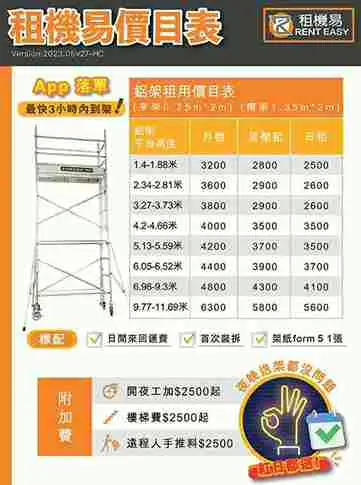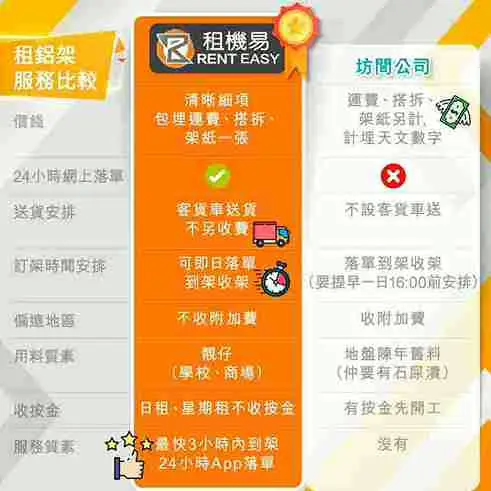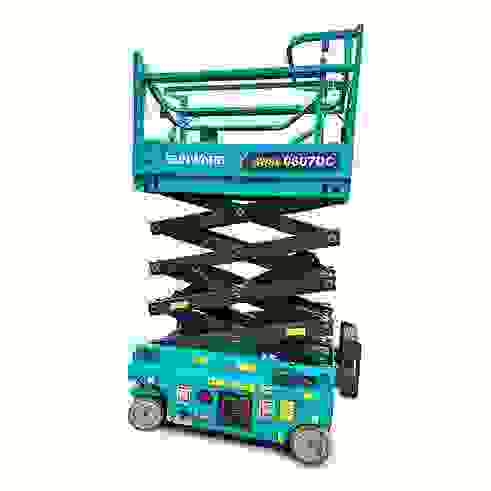高空工作台 | 工作台 | 流動工作台 :常見為鋁架工作台 及 電動工作台 , 一般室內裝修工程可選用 鋁架工作台 作為首選, 主要原因是租期靈活(日租/星期租/月租), 上樓入LIFT 都可以做到。於網上落單可最快3小時送到。
租鋁架工作台相關實用資訊: 鋁架-日租鋁架 月租價目表|鋁架工作台-星期租價目表
租升降台相關實用資訊:履帶升降台 |升降台操作教學-2分鐘|迷你升降台-最低消費如何計算?|小型升降台|手動升降台 攻略【最低星期價錢】|升降台 FORM 1-是什麼?|




鋁架工作台 (闊架)
尺寸: 2 m x 1.35 m x 3.73m
高空工作台 -(鋁架工作台 / 電動工作台)
工作台-租用視乎樓底水平是否一致
樓底一致選用鋁架工作台, 樓底有多個水平選用電動工作台
2.選擇地區
3.送架/送機日期
4.提交後, 租機易會聯絡你安排送架/送機
高空工作台-(鋁架)安全標準嗎?
流動式金屬通架在直杆的底部安裝有小腳輪,而小腳輪應屬旋轉軸承類型,並應固定於通架
的直杆上,這樣即使小腳輪離開了地面也不會脫落。
在樓宇內及樓宇外使用流動式金屬塔式通架須遵守不同的規定:
(a) 在樓宇內使用:
高度與最小底邊長度比率應限於3.5。
(b) 在樓宇外使用:
(i) 高度與最小底邊長度比率不應大於3。露天使用通架時,應把
通架繫緊於施工的樓宇上。
(ii) 當金屬通架位於有強風吹襲的地方,應計算風力,並用壓儎鐵
或牽索等固定通架,使安全系數不少於1.5 。另外,應檢查小腳
輪可承受的額外負荷。
高空工作台-(電動工作台)安全標準嗎?
升降台 (表格一) 由認可人仕簽發
升降台 FORM 1-首次由租機易提供,其後由認可人仕簽發
表格1– 起重機械的每週一次檢 查結果報告 (LALG-F1)
- 由認可人仕(每7天簽發或假後)檢查及簽發- 認可人仕為曾接受租機公司培訓課程的人仕
- 認可人仕為18歲及於其持有接受培訓記錄上有記錄人仕。
- 使用者應每天檢查升降台情況才用機。
- 使用者操作前應熟讀使用指南(按此)
鋁架 優點如下:
- 可以搬料上樓梯及入到升降機使用
- 一般租金較升降台便宜, 因提供日租、星期租 (免除按金及客貨車送貨)
- 客貨車可到及有樓梯的位置都可以使用
- 即搭即用(唔怕機械要維修及充電)
工作台規格因用途而異,一般考慮承重能力、材質(如鋼、不鏽鋼、鋁合金)、高度、長寬尺寸及附加設備(如抽屜、輪子、圍欄等)。標準工作台通常符合ISO或國際安全規範,如EN 131-7、OSHA等。
工作台的英文名稱是 Workbench 或 Work Table。如果指的是工業用途的工作台,也可以用 Industrial Workbench,而維修用則稱為 Maintenance Workbench。
根據不同國家與地區的安全標準,工作台的圍欄高度通常為 90cm 至 110cm,以防止工具或物品掉落,提高工作人員的安全。
輕便工作台的標準會考量 可折疊性、承重能力、材質、是否具備防滑裝置 等。一般來說,輕便工作台需符合 EN 131-7 或 ANSI/OSHA 標準,以確保穩定性與安全性。
根據香港勞工處的安全指引,輕便工作台必須符合以下要求:
穩固、具備防滑裝置
具有適當的承重能力
需有護欄或其他防墜落裝置
符合《工業安全條例》
輕便工作台的英文是 Portable Workbench 或 Lightweight Workbench。如果是摺疊式的,也可稱 Folding Workbench
輕便工作台的價格取決於 材質、品牌、承重能力與功能,一般價位範圍如下:
基本型(木製、簡易金屬):HKD 300 – 800
中階型(鋼製、可折疊):HKD 800 – 2,500
高階型(重型、專業用途):HKD 2,500 – 8,000
流動工作台(Mobile Workbench)是一種 帶有輪子的工作台,方便在不同工作區域移動,常見於 工廠、維修中心、物流倉庫,提升工作效率。
根據香港《職業安全及健康條例》,流動工作台需符合以下法例要求:
必須具備剎車系統,確保穩定性
需標示最大負荷重量,避免超載
使用時,需確保工作台處於水平狀態
如涉及高空作業,需符合《高空工作安全規例》
高空工作台(Elevated Work Platform, EWP)是一種 用於高空作業的工作台,如建築工程、維修、裝修行業,常見類型包括:
剪式升降工作台(Scissor Lift Table)
伸縮臂式工作台(Boom Lift Work Platform)
移動式高空作業平台(MEWP)
高空工作台必須符合以下國際安全標準:
EN 280(歐盟移動式升降工作台標準)
OSHA 1910.67(美國職業安全與健康標準)
ANSI A92.2(美國高空作業設備標準)
選擇輕便工作台時應考量:
承重能力(例如 100kg、200kg 以上)
可折疊性(是否易於存放)
是否具有輪子(方便移動)
防滑設計(確保安全)
品牌與安全認證(如 CE、ISO)
一般來說,工作台的高度應符合人體工學:
座椅式工作台:75cm – 85cm
站立式工作台:90cm – 110cm
高空工作台:根據作業需求調整
| 類型 | 輕便工作台(Portable Workbench) | 流動工作台(Mobile Workbench) |
|---|---|---|
| 特點 | 輕巧、可折疊、易於存放 | 配有輪子、適合頻繁移動 |
| 適用場景 | DIY、維修、臨時工作空間 | 工廠、倉庫、實驗室 |
| 承重能力 | 通常 50kg – 200kg | 可達 200kg – 500kg |
高空工作台的價格取決於 類型、品牌與功能:
剪式升降工作台(Scissor Lift):HKD 10,000 – 50,000
伸縮臂式工作台(Boom Lift):HKD 50,000 – 500,000
移動式高空作業台(MEWP):HKD 15,000 – 100,000